All 2 stroke engines without a reed valve will end up forcing mixture back into the carburettor during part of piston's cycle. Since this mixture will be sucked back into the engine during the next cycle this fuel is not lost, but since it passed the carburettors needle twice (or even three times) this mixture will contain far too much fuel to burn correctly.
The rich condition which results from this is very minor and will not damage the engine or foul a plug, but it will decrease the performance of the engine slightly. A boost bottle is supposed to fix this problem by catching some of the mixture backwash of the engine before it makes it to the carburettor's needle and then release it during the next cycle. By ensuring a consistent mixture ratio, the boost bottle should improve performance and fuel economy.
This article will go step-by-step through the process with side-by-side images of an engine with a boost bottle and an engine without.1
|
Table of Contents
|
A tale of two cycles
Step #1
Due to the downward motion of the piston, fresh gas/air mix is forced through the transfer ports into the combustion side of the piston. This, along with the force of the previous explosion, exhausts the remaining fumes through the exhaust port.
There is no difference here between the regular and boosted engine.
Step #2
The fresh mixture which entered the combustion chamber is now being compressed. Since the piston's skirt has moved past the intake port, fresh gas/air mixture is being pulled into the crank case by the movement of the piston.
Again, there is no change cause by the presence of the boost bottle.
Step #3
The engine takes a full "breath" of fresh gas and air as the piston approaches top dead center2. The gas which is in the combustion chamber is super compressed and ready for combustion.
No change with the boost bottle.
Step #4
The spark plug arcs and the mixture in the combustion chamber begins to burn. The piston begins to fall just as all of the crank case has completed a full "breath."
Step #5
As the combustion continues and the piston is forced down toward the crank case, a little bit of the mixture escapes back toward the carburettor before the intake port is closed. The mixture which is caught in the crank case is forced through the transfer ports toward the combustion chamber.
In the engine without the boost bottle, all of the mixture which backwashed from the intake port passes the needle again and more gas is mixed in.
The boost bottle on the other engine accepts a small amount of the mixture and dissipates the pressure wave before it hits the carburetor. This reduces the wave and limits the amount of extra gas which is added to the mixture.
Step #6
As the recently combusted exhaust is expelled and fresh mixture is drawn into the combustion chamber, the backwashed micture waits to enter the crank case.
In the engine without the boost bottle, the mixture which has passed the needle twice to obtain a far too much fuel will pass the needle one more time before being drawn into the crank case.
The engine with the bottle has some of its mixture in the boost bottle as a pressure wave and some in the carburettor manifold. Theoretically, the mixture waiting to go back into the crank case will be the correct mixture to burn optimally.
Step #7
In the engine without a boost bottle, a rich mixture is pulled into the crank case.
In the engine with a boost bottle, a balanced mixture is pulled into the crank case.
Actual results
Though there are some who will swear by the results34 gained from the installation of a boost bottle, many express their doubts over the effectiveness567 of this "enhancement."
This topic is still vehemently debated by enthusiasts.








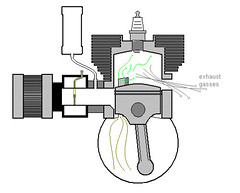


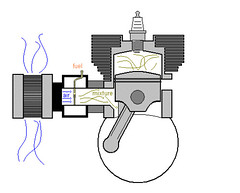
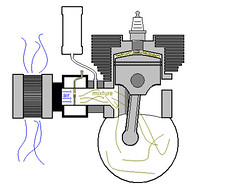

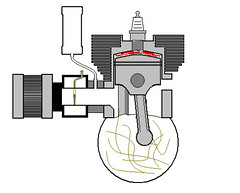

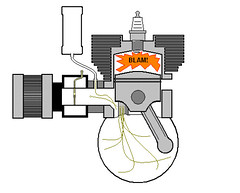
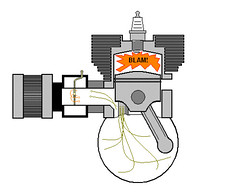
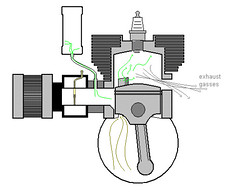
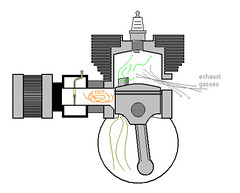
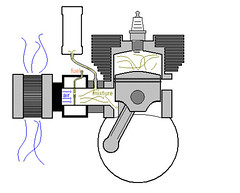
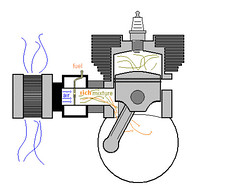




We simply cannot plagiarize material. Posting a link to material or quoting small amounts is perfectly alright, but copying content from another site simply cannot happen.
I am working up my own images description so that the information can be kept as part of the general commons.
Reworked version done!
Your site has the word foul spelled fowl. Fowl is a bird. Foul is a dirty spark plug.
Thanks! Got it.
Want to be an editor? :D
I can not see how this can work. If you have fuel/air mix returning to the carb why would it turn sharply and try and pressurise a bottle? when it will always take the easiest route i.e. back through the inlet tract. I can just see this being a store for stale fuel that will spew out after the bike has been sat not running, if the return theory is correct.There must be a good reason for them…. surely someone knows
Post preview:
Close preview